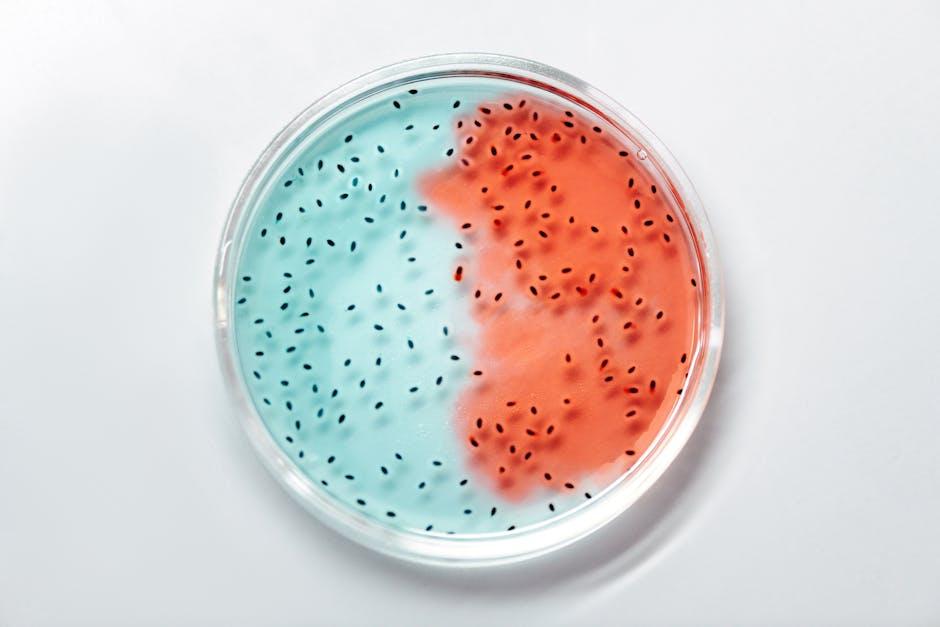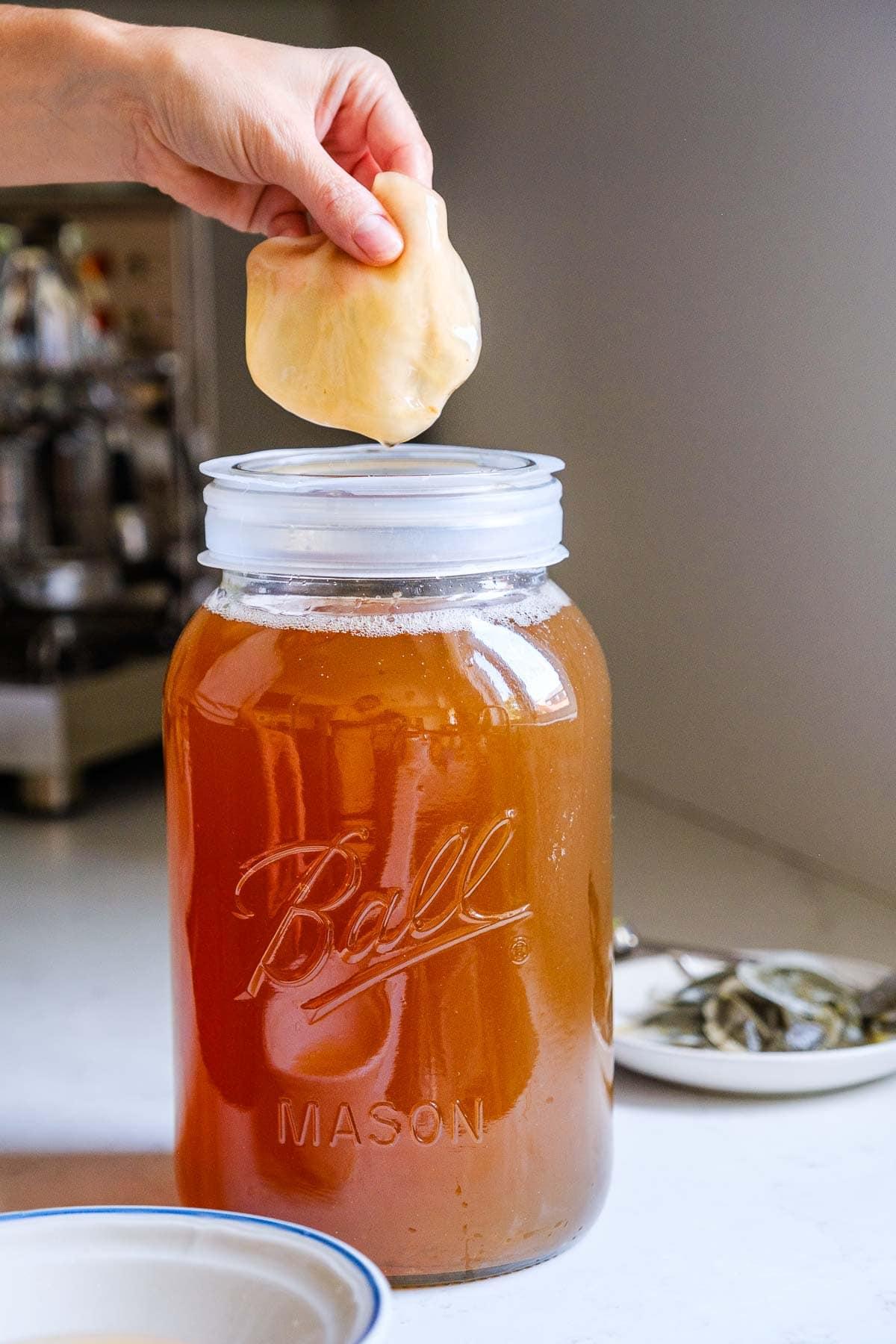Table of Contents
- Exploring the Fascinating Microorganisms Behind Kombucha Fermentation
- Understanding the Science of SCOBY and Its Role in Kombucha Production
- Unveiling the Health Benefits Revealed Through Microscopic Analysis
- Best Practices for Brewing Kombucha at Home with Microbial Safety in Mind
- Insights into the Aesthetic Appeal: What Kombucha Looks Like Up Close
- Q&A
- Closing Remarks


Exploring the Fascinating Microorganisms Behind Kombucha Fermentation
In the intricate world of kombucha fermentation, a unique colony of microorganisms collaborates to transform sweetened tea into the effervescent beverage we love. At the heart of this process are yeasts and bacteria, which work in a symbiotic relationship known as a SCOBY (Symbiotic Culture Of Bacteria and Yeast). This remarkable community is primarily made up of several strains, each playing a vital role in the fermentation process:
- Saccharomyces cerevisiae: This yeast is responsible for alcohol production during fermentation.
- Bacteroidetes: A group of bacteria that aids in breaking down sugars into lactic acid.
- Gluconacetobacter xylinus: Key in producing cellulose and giving kombucha its characteristic texture.
- Lactobacillus: These bacteria contribute to the tangy taste and enhance probiotic benefits.
Observing these microorganisms under a microscope reveals a captivating microcosm. The yeasts float freely, often appearing as fuzzy clusters, while the bacteria tend to group more closely together, forming a dense mat. This complex interaction gives kombucha its signature flavor profile, ranging from sweet to sour, based on fermentation time and the specific strains involved. The fermentation process typically occurs over a period of 7 to 21 days, during which careful environmental control—temperature, light, and oxygen—is essential for optimal growth.
The byproducts of fermentation not only create delightful flavors but also result in various health benefits. Kombucha is rich in probiotics, which support gut health, and organic acids, believed to have detoxifying properties. To illustrate this, here’s a simple comparison table of some essential components produced during fermentation:
| Component | Function | Health Benefits |
|---|---|---|
| Acetic Acid | Antimicrobial agent | Supports weight loss |
| Glucuronic Acid | Detoxification | Enhances liver function |
| Probiotics | Gut health promoter | Boosts immunity |
| Vitamins (B & C) | Nutritional support | Improves skin health |


Understanding the Science of SCOBY and Its Role in Kombucha Production
The remarkable creature known as SCOBY, short for Symbiotic Culture Of Bacteria and Yeast, is the heart of kombucha production. This gelatinous mass acts as a protective barrier, nurturing the fermentation process while simultaneously transforming sweetened tea into the effervescent beverage we all love. Within this culture, a complex ecosystem flourishes, comprising several key players that each contribute to the distinct flavor, aroma, and health benefits associated with kombucha.
Understanding the dynamics at play within the SCOBY is crucial for any budding kombucha brewer. The core components include:
- Bacteria: Primarily acetic acid bacteria (AAB), which convert alcohol produced by yeast into vinegar, contributing to the tangy flavor.
- Yeast: Various strains, including Saccharomyces cerevisiae, that ferment sugars, producing alcohol and carbon dioxide, the latter responsible for kombucha’s fizziness.
- Cellulose: The structure of SCOBY is mainly composed of a matrix of cellulose, which the bacteria produce, helping to trap yeast and protect it during fermentation.
Diving deeper into the science, the fermentation process can be summarized as follows:
| Stage | Activity | Outcome |
|---|---|---|
| First Fermentation | Yeast ferments sugars to produce alcohol and carbon dioxide | Bubbly and slightly alcoholic tea |
| Second Fermentation | Bacteria convert alcohol into acetic acid | Tangy, effervescent kombucha |
In essence, SCOBY is not just a conglomeration of microorganisms; it’s a vibrant community working synergistically to create a unique beverage that has captured the interest of both health enthusiasts and casual drinkers alike. The intricate balance between the yeasts and bacteria within this culture highlights the beauty of fermentation and the artisanal approach to crafting kombucha.


Unveiling the Health Benefits Revealed Through Microscopic Analysis
Exploring kombucha under the microscope reveals a fascinating world of microorganisms working in harmony to create this popular fermented drink. At its core, kombucha is produced through the symbiotic fermentation of sugars by yeasts and bacteria. This unique process not only impacts flavor but also enhances its potential health benefits. For instance, acetic acid bacteria thrive within kombucha, effectively lowering the pH and creating an environment conducive to beneficial properties, including antimicrobial effects.
The diversity of microbial life seen under microscopic analysis sheds light on the complex interactions that occur during fermentation. Identified species such as Lactobacillus and Bifidobacterium play crucial roles in gut health by promoting probiotics, which are known to support a robust digestive system. These beneficial microbes can help balance gut flora, contributing to improved digestion, nutrient absorption, and even bolstering the immune system. Furthermore, the presence of polyphenols from tea leaves, visible in the microscopic environment, offers antioxidant benefits, helping fight oxidative stress in the body.
Moreover, studying kombucha at a microscopic level connects us to its potential therapeutic effects. Research indicates that the bioactive compounds produced during fermentation can help regulate blood sugar and cholesterol levels. The diverse strains of yeast and bacteria can lead to the production of glucuronic acid, which is known for its detoxifying properties. Together, these components showcase the interplay of nutrients and microorganisms that underscores why kombucha has become increasingly recognized beyond just a trendy beverage.
Best Practices for Brewing Kombucha at Home with Microbial Safety in Mind
When brewing kombucha at home, maintaining microbial safety is crucial to ensure a delicious and healthy final product. Begin by sourcing high-quality, organic ingredients to reduce the risk of contaminants. Use filtered or purified water, as tap water can contain chlorine or other substances that may interfere with fermentation. Additionally, opt for loose-leaf tea or organic tea bags free of additives. This contributes not only to the flavor but also to the overall health of your brew by minimizing harmful microbes.
Proper sanitation techniques cannot be overstated in the fermentation process. Always wash your hands before handling any brewing equipment. Sterilize your utensils, jars, and brewing vessels with boiling water or food-safe sanitizers. It’s wise to use a dedicated brewing area, preferably away from pets and other potential sources of airborne contaminants. After brewing, cover your kombucha with a clean cloth secured by a rubber band to keep out dust and insects while allowing for proper airflow.
Throughout the fermentation process, monitor the kombucha closely for signs of spoilage or contamination. This involves observing the color, smell, and texture of your brew. Healthy kombucha should have a pleasant, slightly vinegary aroma and a light, effervescent quality. To aid in this process, consider keeping a fermentation log that tracks each batch’s temperature, pH, and fermentation time. Below is a simple table to help you keep track of your observations:
| Date | pH Level | Temperature (°F) | Notes |
|---|---|---|---|
| 01/01/2023 | 3.5 | 75 | No signs of spoilage, smells good. |
| 01/05/2023 | 3.3 | 72 | Initial fizz observed. |


Insights into the Aesthetic Appeal: What Kombucha Looks Like Up Close
The mesmerizing world of kombucha unveils itself through a high-powered lens, revealing vibrant hues and intricate patterns. When observing kombucha under the microscope, one can spot a translucent, gelatinous layer known as the SCOBY (Symbiotic Culture of Bacteria and Yeast), which is not only the heart of the fermentation process but also a visual feast. This layered structure often presents itself as a thick, cloud-like formation, showcasing bubbles that suggest a dance of carbon dioxide being released. The interplay of colors across various strains can range from deep amber to golden yellows, or even shades of green, reflecting the diverse teas and flavorings used in the brewing process.
Moreover, the microscopic world of kombucha introduces captivating organisms that contribute to its unique characteristics. Under close inspection, one might observe the presence of yeast and bacteria, each type revealing different colors and shapes. Yeast cells typically appear as small, round or oval structures, while bacterial cells might be rod-like or spiral in form. These microorganisms create a complex ecosystem, working in harmony to produce that signature effervescence and tangy taste. Sophisticated dyeing techniques can further enhance the visibility of these tiny life forms, drawing attention to their intricate details.
| Organism Type | Appearance | Function |
|---|---|---|
| Yeast | Round or oval | Fermentation |
| Bacteria | Rod or spiral | Acid production |
the aesthetic appeal of kombucha transcends mere visual observation, inviting further exploration into its sensory dimensions. The surface may show streaks or patches of foam created by fermentation, while the liquid can appear alive with tiny bubbles that rise and burst, contributing to a dynamic visual experience. Each batch tells its own tale through the colors and textures observed under the microscope, hinting at the brewing conditions, ingredients used, and even the environment in which it has fermented. It is an art form of nature, making the appreciation of kombucha not just a culinary experience but also a journey into the unseen beauty of microbial life.
Q&A
Q&A: Exploring Kombucha Under a Microscope
Q1: What exactly is kombucha, and why should it be examined under a microscope? A1: Kombucha is a fermented drink made from sweetened tea, typically black or green, that is home to a symbiotic culture of bacteria and yeast (SCOBY). Examining kombucha under a microscope allows us to observe the intricate world of microorganisms that thrive in this beverage. By doing so, we can understand the fermentation process, the role of various microbes, and the potential health benefits of kombucha.Q2: What types of microorganisms can be found in kombucha? A2: When peering through a microscope, you’ll encounter a diverse array of microorganisms, including bacteria like Acetobacter and Gluconobacter, and yeasts such as Saccharomyces. These beneficial microbes work together during fermentation, transforming sugars into acids, gases, and other intriguing compounds that contribute to kombucha’s characteristic flavor and probiotic properties.
Q3: How does the appearance of kombucha change under a microscope? A3: Under the microscope, kombucha reveals a fascinating landscape. Microbial colonies appear as clusters or filaments, with yeasts often exhibiting oval shapes, while bacteria can take on rod-like or spherical forms. The liquid may show bubbles formed by carbon dioxide, indicating active fermentation. This visual spectacle highlights the complexity of the fermentation process and the vibrant life within each bottle.
Q4: What can we learn about kombucha’s health benefits by examining it microscopically? A4: Microscopic examination can shed light on the probiotic content of kombucha. By identifying specific strains of bacteria and yeast, researchers can link them to potential health benefits, such as improved gut health, boosts to the immune system, and even antimicrobial properties. Understanding these relationships helps consumers make informed choices about how kombucha can fit into a healthy lifestyle.
Q5: Is there a risk of harmful bacteria being present in kombucha? A5: While most cultures in kombucha are beneficial, there is always a potential for contamination if not prepared under strict hygiene standards. Examining kombucha under a microscope can help identify unwanted pathogens or imbalances in the microbial community. It’s a reminder of the importance of proper brewing practices to minimize risks and ensure a safe and enjoyable drink.
Q6: How can hobbyists or aspiring brewers benefit from microscopic examination of their kombucha? A6: For hobbyists and brewers, observing kombucha microscopically can be an enlightening experience. It provides insights into the health of the SCOBY, the fermentation process, and any adjustments needed for optimal fermentation. By understanding microbial activity, brewers can refine their methods to produce more consistent and flavorful batches of kombucha.
Q7: Can anyone examine their kombucha under a microscope, and what tools might they need? A7: Yes, anyone curious about their kombucha can examine it under a microscope! A basic compound microscope with at least 40x magnification will suffice. Additionally, preparing slides with a drop of kombucha solution and a cover slip is relatively simple. Online resources and guides can help beginners make the most of their microscopy experience, unveiling the hidden world of their favorite fermented drink.
By exploring kombucha under a microscope, we open the door to understanding not just the drink itself, but the fascinating microbial ecosystem that makes it unique. From health benefits to brewing tips, the microscopic world of kombucha offers endless opportunities for curiosity and discovery!
